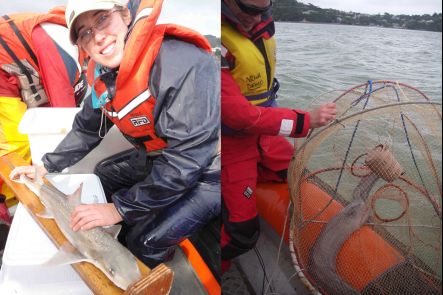
Christy Getzlaff measures the length of an adult rig, and Malcolm Francis observes a large conger eel caught in a baited pot (images: M. Francis, left, and A. Ballance, right)
It's been a bumper summer for shark sightings, and next month NIWA scientists are heading out into estuaries around the country in the hope of seeing even more sharks. Specifically, they are looking for a small shark that is officially known as rig, but which also gets called spotted dogfish, spotted smoothhound, and, in fish and chip shops, lemonfish. Estuaries are important as breeding grounds for rig, and as nursery and feeding grounds for juvenile rig, which spend a few months there after hatching before heading out into open water. The survey hopes to determine the health of rig populations, and clarify which estuaries are nursery grounds, by seeing how many young rig they catch. The survey will also provide a snapshot of the health of estuaries, as it is expected that healthy estuaries will be home to more healthy populations of rig than polluted or sediment-filled estuaries.
Adult rig are known to feed on crabs, and Massey University student Christy Getzlaff hopes to find out what the young rig eat while they are in the estuaries by looking at their stomach contents.
Alison Ballance joins NIWA principal scientist Malcolm Francis, boat skipper Peter Notman, technician Warrick Lyon and student Christy Getzlaff during a pilot survey in Porirua Harbour, as they try to determine whether set nets or pots baited with crab meat are the most effective way of catching rig.
Our Changing World featured an earlier rig survey in Pauatahanui Inlet to collect genetic samples for a comparative study of Australian and New Zealand rig populations.

Crabs are the main component of the diet of adult rig, and Warrick Lyon with an 'opera house' pot, which proved an ineffective way of catching juvenile rig (images: A. Ballance left, and M. Francis, right)


